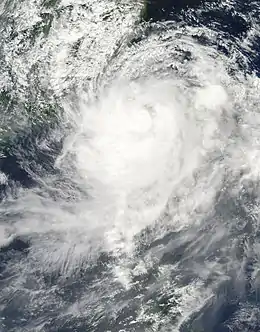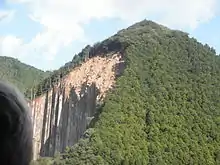List of wettest tropical cyclones
This is a list of the wettest tropical cyclones, listing all tropical cyclones known to have dropped at least 1,270 millimetres (50 in) of precipitation on a single location. Data is most complete for Australia, Cuba, Dominican Republic, Japan, Hong Kong, Mexico, Yap, Chuuk, and the United States, with fragmentary data available for other countries. The French region of Réunion holds several world records for tropical cyclone and worldwide rainfall due to rough topography of the island and its proximity to the Indian Ocean.[1]
Overall wettest

Commerson Crater in Réunion, France has received over 5.5 metres of rain from tropical cyclones on at least two separate occasions.

Typhoon Morakot approaching Taiwan on August 7, 2009. Due to its rugged topography, Taiwan sees extreme rain from tropical cyclones, particularly in its central mountain range.

The heavy rains from Tropical Storm Talas triggered numerous landslides, such as this one in Kihō, across the mountainous terrain of Japan.
_(50).jpg.webp)
Flooding in Texas on August 31, 2017 from Hurricane Harvey. Harvey stalled over the state of Texas for two days due to high pressure ridges on both sides, resulting in massive flooding.
See also
- Extratropical cyclone
- List of the most intense tropical cyclones
- List of tropical cyclone records
- List of wettest tropical cyclones by country
- List of wettest tropical cyclones in the United States
- Tropical cyclone rainfall climatology
- Tropical cyclone rainfall forecasting
- Tropical cyclogenesis
- Wettest known locations
Notes
- May have had a greater amount of precipitation.
- May have had a greater amount of precipitation.
- May have had a greater amount of precipitation.
References
- "Archived copy" (PDF). Archived from the original (PDF) on 2014-04-13. Retrieved 2014-04-11.CS1 maint: archived copy as title (link)
- Landsea, Christopher W; Hurricane Research Division (March 12, 2007). "Subject: E4) What are the largest rainfalls associated with tropical cyclones?". Tropical Cyclone Frequently Asked Questions:. Archived from the original on February 3, 2014. Retrieved April 12, 2013.
- Quetelard, Hubert; Bessemoulin, Pierre; Cerveny, Randall S; Peterson, Thomas C; Burton, Andrew; Boodhoo, Yadowsun. "Extreme Weather: World-Record Rainfalls During Tropical Cyclone Gamede". Bulletin of the American Meteorological Society. American Meteorological Society. 90 (5): 603–608. doi:10.1175/2008BAMS2660.1.
- Paulhaus, J. L. H. (1973). World Meteorological Organization Operational Hydrology Report No. 1: Manual For Estimation of Probable Maximum Precipitation. World Meteorological Organization. p. 178.
- "Thủ tướng Nguyễn Xuân Phúc: Không để dân 'màn trời, chiếu đất'". VietnamPlus. 2020-10-19. Archived from the original on 2020-10-19. Retrieved 2020-10-19.
- Central Weather Bureau (2010). "侵台颱風資料庫". Retrieved October 19, 2011.
- Ikuo Tasaka (1981). "The Difference of Rainfall Distribution in Relation to Time-Scale: A Case Study on Heavy Rainfall of September 8–13, 1976, in the Shikoku Island Caused by Typhoon 7617 Fran" (PDF). Geographical Review of Japan (in Japanese). 54 (10): 570–578. doi:10.4157/grj.54.570. Retrieved January 5, 2016.
- Instituto Nacional de Recursos Hidráulicos (2012). "Lluvias intensas observadas y grandes inundaciones reportadas" (in Spanish). Archived from the original on November 5, 2013. Retrieved April 25, 2016.
- Unattributed (September 9, 2009). "莫拉克颱風暴雨量及洪流量分析" (PDF). Water Resources Agency, Ministry of Economic Affairs, Republic of China. Retrieved July 17, 2011.
- http://docs.lib.noaa.gov/rescue/cd024_pdf/005ED280.pdf
- "FLASH REPORT ON DISASTER RISK MANAGEMENT SITUATION ON 14 OCTOBER 2020". Vietnam Disaster Management Authority. 14 October 2020. Retrieved 17 October 2020.
- Danitofea, S; Baines, Graham BK (October 1987). Cyclone "Namu" and the North Guadalcanal Coast, Solomon Islands: Implications for Economic Development. Workshop on Coastal Processes in the South Pacific Island Nations October 1–7, 1987. Retrieved April 25, 2016.
- Gonghui Wang; Akira Suemine; Gen Furuya; Masahiro Kaibori & Kyoji Sassa (2006). Rainstorm-induced landslides in Kisawa village, Tokushima Prefecture, Japan (PDF) (Report). International Association for Engineering Geology. Retrieved January 5, 2016.
- Unattributed (September 9, 2009). "莫拉克颱風暴雨量及洪流量分析" (PDF). Water Resources Agency, Ministry of Economic Affairs, Republic of China. Retrieved July 17, 2011.
- "Climate Education: Flood". Australian Bureau of Meteorology. Archived from the original on 17 March 2009. Retrieved January 18, 2011.
- Nick Wiltgen (October 21, 2015). "Former Super Typhoon Koppu (Lando) Weakens to Remnant Low over Northern Philippines". The Weather Channel. Retrieved October 21, 2015.
- Alarming Rise in the Number and Intensity of Extreme Point Rainfall Events over the Indian Region under Climate Change Scenario (PDF) (Report). Indian Institute of Tropical Meteorology. August 2009.
- "Typhoon Talas". Japan Meteorological Agency. 2011. Retrieved September 6, 2011.
- Chen Zhi (August 2, 2012). "Typhoon Saola dumps heavy downpours around Taiwan". Xinhua General News. Retrieved August 2, 2012.
- "Typhoon Committee Country report 2007: Vietnam" (PDF). Vietnam Hydro meteorological Service. World Meteorological Organization. November 19, 2007. Retrieved June 5, 2010.
- Joint Typhoon Warning Center; Naval Pacific Meteorology and Oceanography Center (1988). Annual Tropical Cyclone Report: 1987 (PDF) (Report). United States Navy, United States Air Force. Retrieved July 1, 2014.
- Lianshou, Chen. Topic 2.1 Observing and forecasting rainfall. Fifth International Workshop on Tropical Cyclones. Retrieved August 4, 2012.
- "Typhoon Sinlaku Central emergency operation center No.12". Central emergency operation center. September 16, 2008. Retrieved January 13, 2009.
- U. S. Geological Survey. "Landslide Response to Hurricane Mitch Rainfall in Seven Study Areas in Nicaragua" (PDF). Retrieved 2007-02-19.
- Roth, David M. "Maximum Rainfall Caused By Tropical Cyclones and their remnants per Mexican state (1981-2010)". Hydrometeorological Prediction Center: Tropical Cyclone Point Maxima. National Oceanic and Atmospheric Administration. Retrieved 2012-09-10.
- Chiu Yu-Tzu (July 20, 2005). "Haitang fizzles out, leaves Taiwan wet". Taipei Times. Retrieved April 11, 2010.
- Roth, David M. (October 18, 2017). "Tropical Cyclone Point Maxima". Tropical Cyclone Rainfall Data. United States Weather Prediction Center. Retrieved November 26, 2017.
- Padgett, Gary. "Monthly Global Tropical Cyclone Summary: November 2004". Retrieved June 10, 2012.
- Climatological Data: National Summary. 22. National Oceanic and Atmospheric Administration. January 1971. p. 771. Retrieved April 12, 2013.
- "Super Typhoon Halong to Affect Korea This Week". The Chosunilbo. August 3, 2014. Retrieved August 3, 2014.
- Dr. Wilfried Strauch (November 2004). "Evaluación de las Amenazas Geológicas e Hidrometeorológicas para Sitios de Urbanización" (PDF). Instituto Nicaragüense de Estudios Territoriales (INETER). p. 11. Retrieved 2009-11-07.
- Padgett, Gary (December 27, 2006). "Monthly Global Tropical Cyclone Summary January 2002". Australian Severe Weather Index. Jimmy Deguara. Retrieved January 16, 2007.
- India Meteorological Department (1961). "Annual Summary — Storms & Depressions: Depression in the Bay of Bengal" (PDF). India Weather Review. National Oceanic and Atmospheric Administration: 10–11.
- (in Japanese) "台風200514号 (Nabi) - 災害情報". National Institute of Informatics. 2011. Retrieved December 31, 2011.
- Hawaii 72 hour archive of the RR5HFO summary. National Weather Service (Report). National Oceanic and Atmospheric Administration. Retrieved 26 August 2018.
- Kodama. NATIONAL WEATHER SERVICE HONOLULU HI. National Weather Service (Report). National Oceanic and Atmospheric Administration. Retrieved 26 August 2018.
- Central Pacific Hurricane Center. Tropical Cyclones During the Years 1900–1952 (Report). United States National Oceanic and Atmospheric Administration's National Weather Service. Retrieved January 26, 2007.
- Bureau of Meteorology. Tropical Cyclones in Queensland. Retrieved on 17 July 2015.
- (in Japanese) "台風199211号 (Kent) - 災害情報". National Institute of Informatics. 2011. Retrieved December 31, 2011.
- IMD. "IMD Pune Climate Bulletin Nov 2008" (PDF).
- The Hindu (2008-11-28). "Rain-related death toll rises to 51". Retrieved 2010-06-08.
- Regional Specialized Meteorological Center New Delhi, India (January 2009). "Report on Cyclonic Disturbances over North Indian Ocean during 2008" (PDF). India Meteorological Department. Archived from the original on April 5, 2010. Retrieved January 17, 2013.
This article is issued from Wikipedia. The text is licensed under Creative Commons - Attribution - Sharealike. Additional terms may apply for the media files.